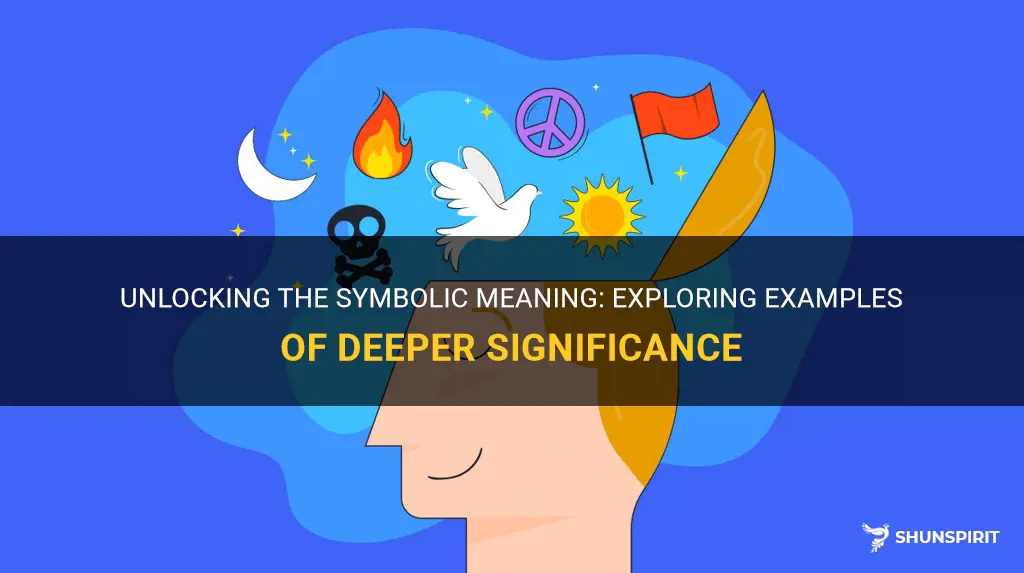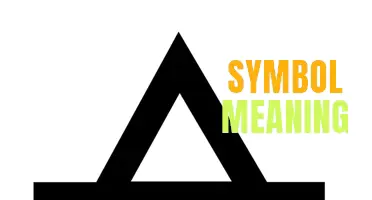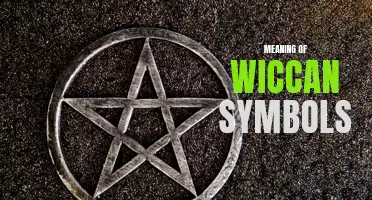
Symbolic meanings hold a special significance in human culture throughout history, as they often convey deeper messages and emotions beyond their literal representation. Whether it's an ancient hieroglyph, a religious symbol, or a powerful emblem, symbols have the power to evoke strong emotions, represent abstract concepts, and communicate universal truths. In this article, we will explore some fascinating examples of symbolic meanings and how they have shaped various aspects of our lives.
What You'll Learn
- Can you provide some examples of symbolically meaningful objects?
- How does symbolism play a role in literature and storytelling?
- What are some common symbolic meanings associated with colors?
- Can you explain the symbolic meaning behind certain animals in various cultures?
- How can symbols be used to represent abstract concepts or ideas?

Can you provide some examples of symbolically meaningful objects?
Symbolically meaningful objects are items that hold deep significance and convey important messages or emotions. These objects may carry personal or cultural significance and can be interpreted and understood by those who are familiar with the symbols and their associated meanings. Here are some examples of symbolically meaningful objects that hold significance in various cultures and contexts.
- Wedding Ring: A wedding ring is a universal symbol of love and commitment between two individuals. It represents the eternal bond and promises made in a marriage. Often worn on the fourth finger of the left hand, it is believed to be connected to the heart by a vein, known as the "vein of love."
- National Flag: Flags hold great significance as they represent a country's identity, values, and history. These symbols are often a source of pride and patriotism for its citizens. The colors, shapes, and symbols on a national flag often have specific meanings related to the country's culture, heritage, and political ideologies.
- Crucifix: A crucifix is a powerful symbol in Christianity, representing the sacrifice and resurrection of Jesus Christ. It is a depiction of Jesus nailed to a cross, reminding believers of his suffering and ultimate redemption. The crucifix is often displayed in churches, homes, and worn as a pendant by Christians around the world.
- Dreamcatcher: Dreamcatchers are a Native American symbol representing protection and the filtering of dreams. The intricate design features a woven hoop with a web-like pattern, often decorated with feathers or beads. According to Native American folklore, the dreamcatcher catches bad dreams in its web and allows positive dreams to pass through.
- Yin and Yang: The yin and yang symbol is an ancient Chinese concept representing the balance and harmony of opposing forces. The circle is divided into two halves, one in black (yin) and the other in white (yang), with a small dot of each color within the opposite half. It signifies the dualistic nature of the universe, such as light and dark, masculine and feminine, or good and evil.
- Peace Sign: The peace sign is a popular symbol used by various peace movements and advocates for nonviolence. It originated in the 1950s as a combination of the semaphore signals for "N" and "D," standing for nuclear disarmament. Since then, it has become a widely recognized symbol for peace, unity, and protest against violence.
- Ankh: The ankh is an ancient Egyptian symbol representing eternal life and power. It resembles a cross with a loop at the top and is often seen in the hands of gods and goddesses in Egyptian art. The ankh was believed to bring about blessings and protection, and it was often associated with fertility, regeneration, and wisdom.
- Buddhist Prayer Beads: Buddhist prayer beads, also known as mala beads, are used by Buddhists and followers of other Eastern spiritual traditions for meditation and prayer. The beads serve as a reminder to stay mindful and focused during the practice. Each bead represents a mantra or prayer, and the repetitive movement of the beads encourages calmness and spiritual connection.
Symbolically meaningful objects can be found in every culture and hold power in their ability to convey deep messages and emotions. Their significance lies in the shared understanding and interpretation of their symbols, allowing individuals to connect on both personal and cultural levels. These objects serve as reminders of beliefs, values, and traditions, creating a tangible representation of something larger and more profound.
Understanding Crochet Symbols: Their Meaning and Usage
You may want to see also

How does symbolism play a role in literature and storytelling?
Symbolism is an integral aspect of literature and storytelling. It adds depth and meaning to the narrative, allowing readers to engage with the text on a deeper level. Whether it is a simple object or a complex image, symbolism can convey themes, emotions, and ideas that might otherwise be challenging to explore directly. In this article, we will discuss how symbolism plays a crucial role in literature and storytelling.
One of the primary functions of symbolism is to enhance a story's themes and messages. By using symbols, authors can effectively communicate abstract concepts and universal ideas. For example, in Nathaniel Hawthorne's novel "The Scarlet Letter," the scarlet letter ‘A' functions as a symbol of sin and guilt. As the story progresses, the symbol evolves, reflecting the characters' growth and transformation. This symbol not only emphasizes the theme of sin and redemption but also adds depth to the characters' internal struggles.
Symbols can also evoke emotions and create an atmosphere in a story. They can be used to represent specific emotions or feelings, allowing readers to connect with the characters and their experiences on a more personal level. For instance, in F. Scott Fitzgerald's "The Great Gatsby," the green light at the end of Daisy Buchanan's dock symbolizes Jay Gatsby's hopes and dreams. This symbol not only reflects Gatsby's pursuit of wealth and status but also elicits a sense of longing and unattainability.
In addition to enhancing themes and emotions, symbols can also serve as a means of foreshadowing or hinting at future events. Authors often use symbols to provide subtle clues or indications of what might happen later in the story. These symbols engage readers and invite them to make connections, fostering an active and immersive reading experience. An example of this is the mockingbird in Harper Lee's "To Kill a Mockingbird." The innocent bird symbolizes various characters throughout the novel, including Tom Robinson, Boo Radley, and even the children themselves. Its presence signals the impending injustice and prejudice that the characters will face.
Symbolism can also be employed to highlight societal issues and critique norms and ideologies. By using symbols to represent larger social, political, or cultural forces, authors can encourage readers to question and reflect on these issues. George Orwell's "Animal Farm" is a classic example of this. In the novel, the various animals symbolize different social classes and political ideologies, reflecting the corruption and hypocrisy of power. Through these symbols, Orwell critiques the failures of communism and dictatorship, inviting readers to consider the dangers of absolute power.
In conclusion, symbolism plays a vital role in literature and storytelling. It adds layers of meaning, evokes emotions, foreshadows events, and critiques societal issues. By employing symbols effectively, authors can create a more immersive and thought-provoking reading experience. So next time you read a book or watch a movie, pay attention to the symbols scattered throughout - they might reveal more than meets the eye.
Demystifying the Circle with Arrow Symbol: What Does it Mean?
You may want to see also

What are some common symbolic meanings associated with colors?
Colors have long been used as symbols to convey various meanings and emotions. Different cultures and societies have ascribed different symbolic meanings to colors, and these meanings can vary widely depending on context. Here are some common symbolic meanings associated with colors:
- Red: Red is often associated with strong emotions such as love, passion, and anger. It can represent both warmth and danger. In many cultures, red is also a symbol of luck and good fortune.
- Blue: Blue is often associated with calmness, tranquility, and stability. It can evoke feelings of trust and loyalty. Blue is also frequently associated with the vastness of the sky and the ocean, representing depth and infinity.
- Yellow: Yellow is often associated with happiness, optimism, and energy. It can represent sunshine and warmth, and is often used to evoke feelings of joy and positivity. In some cultures, yellow is also associated with cowardice or deceit.
- Green: Green is often associated with nature, growth, and renewal. It can represent fertility, abundance, and balance. In Western culture, green is also associated with envy or jealousy.
- Purple: Purple is often associated with royalty, luxury, and power. It can represent creativity and spirituality. Purple is also associated with mystery and magic, and has a calming effect on the mind.
- Orange: Orange is often associated with enthusiasm, excitement, and creativity. It can represent warmth and energy. In some cultures, orange is also associated with spirituality and transformation.
- White: White is often associated with purity, innocence, and cleanliness. It can represent new beginnings and the absence of color. White is also commonly associated with weddings and religious ceremonies.
- Black: Black is often associated with mystery, darkness, and power. It can evoke feelings of elegance and sophistication. In many cultures, black is also associated with mourning and death.
It is important to note that these symbolic meanings can vary across different cultures and individual interpretations. Colors can evoke different emotions and associations based on personal experiences and cultural backgrounds. Additionally, the context in which a color is used can also influence its symbolic meaning. Understanding the symbolic meanings associated with colors can be helpful in art, design, and communication, allowing individuals to convey specific messages and emotions through the use of color.
The Meaning Behind the Circle with Plus Sign Symbol
You may want to see also

Can you explain the symbolic meaning behind certain animals in various cultures?
In many cultures around the world, animals hold great symbolic meaning. From ancient times to the present, different animals have been associated with specific traits, characteristics, and values. The symbolic meanings attributed to these animals often vary depending on the culture and region. Let's explore some common examples of animals and their symbolic meanings in various cultures.
- Dragon: In many East Asian cultures, the dragon is a symbol of power, strength, and good fortune. It is often seen as a benevolent creature that has control over water, rain, and rivers. Chinese dragon is especially revered and considered a symbol of imperial power and prosperity.
- Lion: The lion is a powerful symbol of courage, strength, and royalty. It is often associated with leadership and is commonly seen in heraldry and architecture. In African cultures, the lion represents bravery, dominance, and protection.
- Eagle: The eagle is a widely revered bird symbolizing freedom, courage, and vision. It is often seen as a messenger between gods and humans. In Native American culture, the eagle has strong spiritual connotations and is considered a symbol of wisdom, strength, and protection.
- Snake: The snake has complex symbolic meanings in different cultures. In some, it represents evil, deceit, and temptation, while in others, it signifies healing, rebirth, and transformation. In ancient Greek and Egyptian cultures, the snake was associated with healing and divine wisdom.
- Owl: The owl is often associated with wisdom, intuition, and foresight. It is seen as a guardian of ancient knowledge and is regarded as a spiritual guide in many cultures. In ancient Greece, the owl was the symbol of Athena, the goddess of wisdom.
- Elephant: The elephant is highly regarded in many Eastern cultures and is considered a symbol of strength, wisdom, and good fortune. It is often associated with prosperity and is used in various symbols and rituals.
- Butterfly: The butterfly is a symbol of transformation, rebirth, and beauty across various cultures. It represents the soul, change, and spiritual growth. In many traditions, the butterfly is seen as a messenger from the spirit world.
- Wolf: The wolf is often seen as a symbol of loyalty, intelligence, and spirituality. In Native American cultures, it represents the importance of community, family, and unity. It is also seen as a powerful animal spirit guide.
These are just a few examples of the symbolic meanings associated with animals in various cultures. Each culture has its own unique interpretations and beliefs about animals. Understanding these symbolic meanings can provide insights into the values and beliefs of different societies and help us appreciate the deep connection between humans and animals throughout history.

How can symbols be used to represent abstract concepts or ideas?
Symbols have been used for centuries to represent abstract concepts or ideas. They allow people to communicate complex ideas without the need for lengthy explanations or detailed descriptions. Symbols are powerful tools that can convey deep meaning, evoke emotions, and create connections between different individuals or cultures.
One way symbols are used to represent abstract concepts is through their visual representation. By creating unique and recognizable shapes or images, symbols can become a visual shorthand for a particular idea or concept. For example, the dove is often used as a symbol of peace, while a heart is commonly associated with love. Visual symbols can be easily understood and recognized by people from different backgrounds, making them a universal language of communication.
Another way symbols can represent abstract concepts is through their association with specific meanings or attributes. For instance, the color red is often used to symbolize passion or danger, while a snake can be a symbol of deception or evil. These associations are often cultural or historical in nature, and they can vary across different societies or time periods. Symbols can also acquire new meanings or evolve over time, reflecting changing social attitudes or beliefs.
Symbols can also be used to represent abstract concepts through their use in storytelling or literature. For example, the tree of knowledge in the biblical story of Adam and Eve represents the concept of temptation and the consequences of disobeying divine orders. In literature, symbols are often used to represent complex ideas or emotions that cannot be easily described in words. Through the use of symbols, authors can evoke powerful images or convey deeper meanings that resonate with their readers.
Symbols can also be used to express personal beliefs or values. People often choose to wear or display symbols that represent their affiliations or beliefs, such as religious symbols or symbols of political ideologies. By using symbols, individuals are able to communicate their identity or align themselves with a particular group or cause.
In conclusion, symbols are powerful tools that can be used to represent abstract concepts or ideas. Whether through their visual representation, associations with specific meanings, use in storytelling, or expression of personal beliefs, symbols have the ability to convey deep meaning and create connections between individuals or cultures. By understanding and interpreting symbols, we can gain insight into the complex world of abstract concepts and ideas.
Exploring the Symbolic Powers and Meaning Behind Hands
You may want to see also
Frequently asked questions
The dove is often seen as a symbol of peace and love. In many religions and cultures, it is believed to represent the presence of the Holy Spirit. The image of a dove carrying an olive branch has become a universally recognized symbol of peace.
Snakes are often associated with transformation and rebirth. In many cultures, they symbolize fertility and the cycle of life, as they shed their skin and emerge anew. Snakes can also represent hidden knowledge and wisdom, as seen in the story of the Garden of Eden.
Lions are often regarded as symbols of courage, strength, and leadership. They are commonly associated with royalty and nobility, as they are often referred to as the "king of the jungle." The lion can also represent power and authority, as seen in various mythologies and coat of arms.
The lotus flower is highly regarded in Asian cultures, particularly in Buddhism and Hinduism. It is seen as a symbol of purity, enlightenment, and spiritual awakening. The lotus flower grows in muddy waters but rises above the surface, representing the ability to overcome obstacles and achieve enlightenment.







